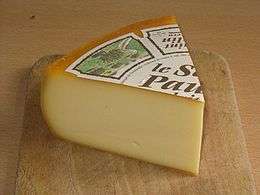Saint-Paulin cheese
Saint Paulin is a creamy, mild, semi-soft French cheese made from pasteurized cow's milk, originally made by Trappist monks.[1][2] It is a buttery cheese, but firm enough for slicing. Saint Paulin is similar to Havarti and Esrom, and is suited to serving as a table or dessert cheese; it is often served with fruit and light wine. Genuine Saint Paulin has an edible yellow-orange rind. It is ripened in a round loaf with slightly protruding sides, and matures in about four weeks.
| Saint Paulin | |
|---|---|
 | |
| Country of origin | France |
| Source of milk | Cows |
| Pasteurized | Yes |
| Texture | Soft pressed cheese |
| Aging time | 4-5 weeks |
| Wikimedia Commons has media related to Saint_Paulin. |
A cousin to Port-Salut, this cheese was originally made by Trappist monks at Saint Paulin. It is made with pasteurised milk and has a washed rind. Curdled, stirred, drained and bathed in brine, the crust has a touch of annatto to give it a distinctive orange tint. Saint Paulin spends three weeks in a ripening chamber. It is a subtle cheese, with a hint of sweetness, this tasty cheese has a taste of slightly acidulated fresh milk.
References
- R. Andrew Wilbey; J.E. Scott & Richard K. Robinson (2012). Cheesemaking Practice. Springer Science & Business Media. p. 211. ISBN 9781461558194. Retrieved 9 August 2019.
- P. F. Fox (2004). Cheese: Chemistry, Physics and Microbiology, Volume 1: General Aspects. Academic Press. p. 273. ISBN 9780122636523. Retrieved 9 August 2019.
See also
- Port Salut, another Trappist cheese from France